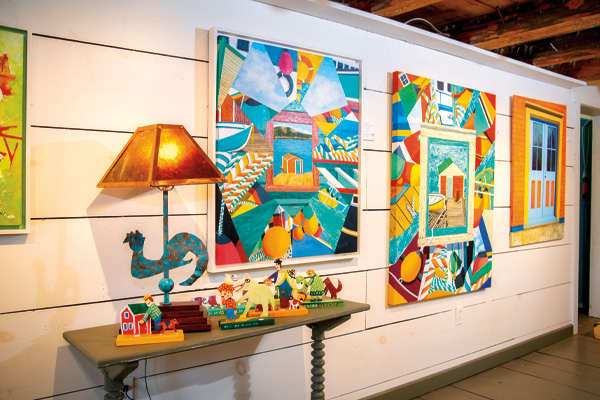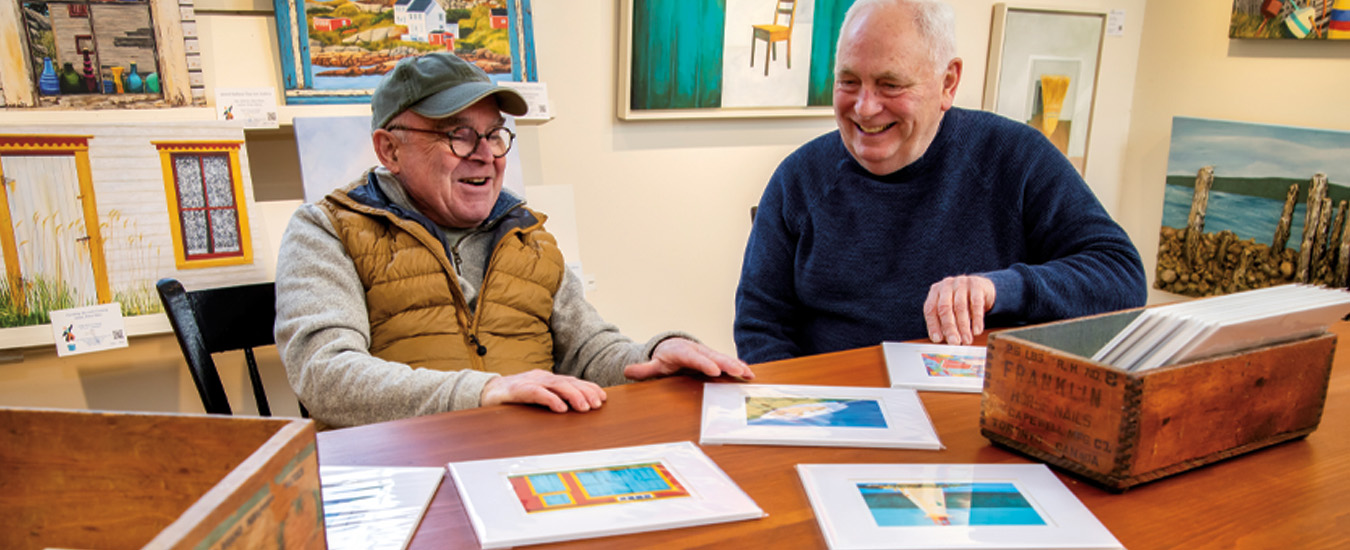Happiness abounds at the Maritime Painted Saltbox Gallery
Tom Alway and Peter Blais, the artists and owners behind the Maritime Painted Saltbox Fine Art Gallery in Petite Riviere, Nova Scotia, sit at a resplendent reproduction harvest table in their brightly lit antique-barn-turned-gallery. Surrounded by their vibrant and colourful art, the duo’s exuberant storytelling is frequently punctuated by bursts of robust laughter.
Alway and Blais moved to Nova Scotia from Ontario in 1997 after more than three decades working in theatre, film and television. It seemed inevitable the men would find their way to Nova Scotia: Alway’s paternal grandmother was born in Greenfield, Lunenburg County and Blais’ maternal grandfather, whose first language was Gaelic, was the first superintendent of Cape Breton Highlands National Park. “So we’re not really come-from-aways,” declares Alway proudly.
In the beginning
Alway and Blais initially purchased and lovingly restored a heritage home in Mahone Bay where they first established the Maritime Painted Saltbox Fine Art Gallery.
“We hadn’t really done our due diligence,” says Blais, “but as ‘children of the ’60s’, we believed we could do anything.
I was still a regular on a television series in Toronto and I hadn’t told the producers that we’d bought a house in Nova Scotia and sold our house in Ontario. But they flew me back and forth for the next two years. Over time, the gallery became more important and show business lost a bit of its magic.”
Initially, the men focussed on creating high quality heritage reproduction furniture in addition to their fine art. “It was in Mahone Bay that I was first approached by the Nova Scotia Folk Art Society to participate in their annual Lunenburg show,” says Blais. “The colour and whimsy of the art paid perfect homage to Lunenburg County.”

Bruce Murray / VisionFire
In 2005, Blais and Alway sold their Mahone Bay home and purchased the property in Petite Riviere where they now live and work. It was a perfect fit as it came with a barn which now serves as their gallery, with four showrooms on two levels.
“The previous owners did some of the heavy lifting for us, moving it to a retail space,” says Blais. “We turned a dark and mysterious antique barn into a gallery blasted with light. It’s a wonderful space and people feel very welcomed and comfortable here.”
Each artist has his own workspace: Alway works from a small cabin perched on a hillside behind their home and Blais works from a sunroom attached to the house. Now in their 23rd year as gallery owners, they couldn’t be happier.
The men produce very little furniture now—a few vibrantly painted benches and console tables.
“It’s a question of time,” says Blais. “We are more prolific as painters.”
Artistic visions
“We had no inclination to paint the rolling surf or the beach or lighthouses when we started,” says Blais. “We never saw ourselves as a seasonal tourist business. So we stumble forward, looking around us, painting the things around us. In the end we’re painting ‘of this place’.”
Pointing to a large canvas on the gallery’s upper wall, Alway explains, “This window is on a building as you drive toward Barrington. These are barrels that were sitting in one of our clients’ living room. This is a boat I’ve painted before, so that’s how I construct my paintings, which is all very local.”
“With us, people see things they are familiar with. We’ve had real fishermen come in and say they never expected to see their lives on a gallery wall.”
“We also do commissions,” adds Alway. “Very fun sorts of things. But we always stipulate that no money changes hands —the client gets first refusal. Because of that we will not paint anything that we believe we can’t sell.”
Welcoming the world to their doors
Having sold art to clients around the globe, Alway and Blais delight in welcoming visitors to their gallery and taking time to get to know them.
“We quickly discovered how important people really are. Every person who comes through that door has a story,” says Alway. “We try to solicit that story to make them comfortable and know they are welcomed. We can sometimes stand and talk for half an hour before they even see the gallery. People are coming to see our art but they are just as important as our art.”
Tourism branding expert Roger Brooks, once hired to scout out the greater Lunenburg area, happened upon the Maritime Painted Saltbox one year and emphasized to Alway and Blais that people are four times more likely to buy a piece of art if they’ve met the artist.
“A gallery owner has to be hugely engaged to make you feel that you’ve met the artist,” says Blais. “The art has a back story to it—once they meet the artist—so it becomes more than a pretty picture on a wall that they are taken with.”
“And we tell children we have only one rule in this gallery: ‘Be very careful on the stairs!’ That’s the only rule. We’re not at all bothered that kids might touch something—go ahead and touch it.”
Alway fondly recalls a visit from a family with three pre-teen children. “The kids got their free postcards and the parents were shopping for a painting. As they were leaving, the mother said the kids would like to do something for us. They went to their vehicle and brought in two violins and gave us a concert! They were just about to go into rehearsals for the [Royal Nova Scotia International] Tattoo. I was so impressed with their willingness just to be visible. At that age that I didn’t even want people to look at me!”
Community, humour and the future
Alway and Blais developed the first (then black-and-white) Petite Rivière/LaHave and Area Guide Map years ago to draw attention to the many other artisans, museums, shops, restaurants, accommodations and attractions in their tight-knit community. Now printed in colour, the map has become a successful not-for-profit venture with the same mission.
“What you contribute to your community is more important than your business,” says Alway. “The map will tell you, ‘you’re here now but if you can’t find what you’re looking for, just look over here’. There are about 42 places of interest on the current map.”
“For years, we also did a group show here and invited maybe a dozen artist friends,” says Blais. “We’d remove our stuff from the walls to allow other artists to show their work for a week, no commission. These are career artists who don’t have their own space. It was delightful to make sales for them. Some of our clients had never seen their work because they didn’t have access to a gallery.”
Encouraging fun at the gallery in general, Alway and Blais are the first to not take themselves too seriously. They find particular amusement in the signs they post to direct visitors to the gallery. One for people approaching from Lunenburg reads “Buy art from living artists, the others don’t need the money.” Another says “People buy art for all the wrong reasons and we have no problem with that.”
Especially amusing to the men was the time someone had fun rearranging their signs on Italy Cross Road. The originals read “The road to bad art is paved with good intentions, the road to good art is straight ahead”. After a wee bit of alteration, the message became “The road to bad art is straight ahead.”
“Probably kids on bicycles!” laughs Alway.
“We’ve come to business really late, we wish we had been more business-like in those years of show business,” says Blais. “But somehow we have been able to demystify the whole gallery experience and people feel welcome here, people who may not go into a big city commercial art gallery.”
“This is our future, this is what we’re working on now,” says Alway as he glances at the gallery walls. “But we know that at a certain point we just aren’t going to be able to carry on with the gallery.
“Presently, in addition to our original art, we’ve moved into canvas prints and we have metal prints this year which have been extraordinarily popular. We’re always trying to find ways to do more e-commerce. You can only paint so many pictures a year.”
Despite delays in opening and reduced international travel due to COVID-19 protocols, 2021 was a record-breaking year for the Maritime Painted Saltbox Gallery. “Nova Scotians were forced to stay home and look around them for new places to visit,” explains Blais.
For the artists and visitors alike, the Maritime Painted Saltbox Gallery is indeed a happy place.
